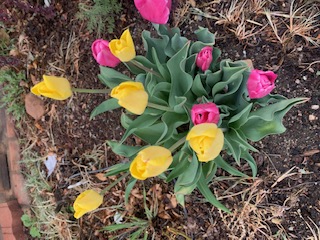THE OPTIMISTIC FARMER-April 2025
- theoptimisticfarme
- Apr 1
- 4 min read
Updated: May 2
2025 April Edition
Tall and (Small) Tales from the Great Basin of Northeast Nevada

Up until now, the last few months for the gardener have been a little of this and a little of that; however, now we are talking April! Warmer days are definitely becoming more common, and we may even start seeing some blooms from spring bulbs that were planted last fall. If you threw out some spinach or lettuce seeds a few weeks ago, they should also be making an appearance. Long story short, April is a glorious month in the life of a gardener!
Pro Tip: Don't be fooled—it has been known to freeze and snow in April, so have your plant covers ready and keep an eye on the forecast!
News from the garden
Hello April, my old friend, it is so grand for you to return again...we have arrived at the first full month of spring. April is known for sending gardeners around the world back into action! April is the month when it finally feels like spring; you can smell it in the air, you can see it in the plants and trees as they start to awake from their winter sleep. Wakey, wakey lilacs, forsythia, daffodils, and tulips!
Innovations and Ideas
If you tried winter sowing, now is the time to check your containers for signs of life. As the days get warmer, you should start seeing more growth! It is always very exciting to see the germination, and the link below discusses several methods you can use to transplant your treasures into your garden. A personal favorite is the HOS (Hunk of Seeds) method, mostly because it is just fun to say "hunk of seeds"; however, the idea is legit!

Inner Work
Sometimes the best thing you can do for your mental health is to just have fun and what is more fun than a game of BINGO? Now if you get a chance to play garden bingo, life just doesn't get much better than that, also if you win, you can go buy yourself a new plant!!

Dear Optimistic Farmer:
To submit questions to The Optimistic Farmer, click here: theoptimisticfarmer@outlook.com
Inquisitive Reader: What does it mean to harden off your plants you started indoors?
The Optimistic Farmer: Hardening off your seedlings that you started indoors is the practice of gradually introducing them to the elements outside in order to toughen them up for transplanting outside. Start hardening your plants a week or so before you plan on transplanting them. Start by putting them outside for a few hours and increase the time each day, so they can get used to the sun, temperatures and wind. Daytime temps should be between 45- and 50-degrees F for optimal acclimation.
Plants in Science:
Soil, seeds, sun, and water—the big four in gardening and farming. Today we discuss water and what information you may find out if you test your water. The quality of the water you put on your plants will likely impact the final result, so taking a water sample and having it tested may give you the information you need to make modifications or mitigate issues. You can buy simple water analysis kits to test for pH, iron, etc., additionally many cities and towns offer water testing services, whether it be a public or private lab, have conversations with them, so you know what options you have as far as what to analyze. You may also be able to get water sample bottles from the lab with instructions on how to gather your samples. For example, you may find your water source is high in saline, which over time may cause degradation of your soil. Information is knowledge and getting the foundational information regarding your water will aid in making better decisions. Routinely sampling your water to monitor possible changes in your water supply is a good idea. Most municipalities that provide water services to communities will publish the results of water samples or make them available if asked, so if you are using city water the analysis may already be available.
Some things water can be tested for include, but are not limited to the following:
Chlorine levels
Total dissolved solids (TDS) - such as salts, minerals, and metals
Lead
Iron
Bacteria
Arsenic
pH levels
Last, but Not Least: Composting
If you haven't already started composting, April is a fantastic month to start. The great thing about composting is you can start as little or large as you like. Composting can be as easy as throwing your kitchen scraps into a coffee can or as large as multiple compost piles and bins outside. You can also find cool composting barrels to start your composting journey. Composting consists of four main ingredients: browns (carbon-rich materials), greens (nitrogen-rich materials), water, and air! Composting is a great way to enrich your soil with nutrients essential for healthy plants. Compost organic items such as fruit and vegetable peels, grass clippings, and dry leaves. Turning the pile on a regular basis will speed up the decomposition of the materials into a rich soil. Compost also reduces landfill waste and is basically free fertilizer for your garden. Common misconceptions such as compost piles being smelly or attracting unwanted pests are urban legends, and if composting is done correctly, neither of these problems will occur!
Examples of browns include: dried leaves, shredded paper or boxes (no gloss or colors), twigs and
Examples of greens include: Coffee grounds, fruit and vegetable scraps, eggshells, and grass clippings






















Comments